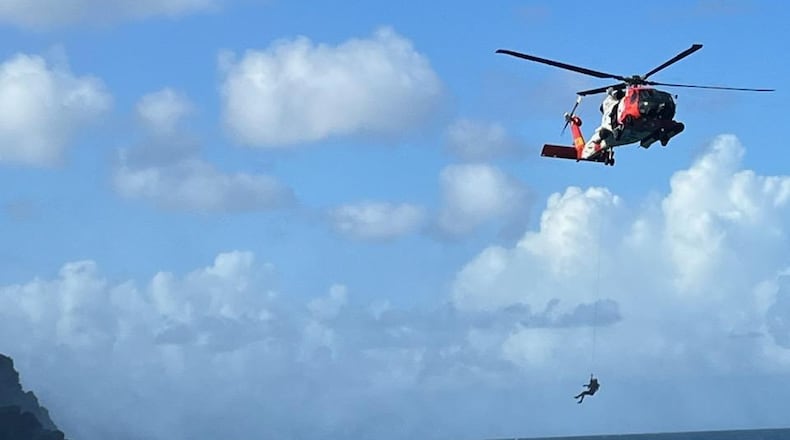Dean Waggenspack, a career coach, and his wife, Rose, had planned the trip to St. Croix as a way to get together with their adult children over the Thanksgiving holiday. But the trip took a wild turn when a hiking accident near the Annaly Bay-Carambola tide pools left Waggenspack trapped in a cave-like shaft with water up to his chest.
Waggenspack described how Annaly Bay-Carambola tide pools were a popular sight on the island, so they planned the walk there on Nov. 22 after getting to St. Croix the evening before.
“I do a lot of hiking, but I’m also a very, very cautious person,” Waggenspack said. “I was being as safe as I possibly could.”
They planned to go sight-seeing at the tide pools at low tide to be careful, but when Waggenspack was walking near the shore, three large waves one right after the other knocked him off his feet and pulled him into a blowhole near the tide pools.
“I was in a small space in a bunch of coral rock,” Waggenspack said. “I had no idea where I was.”
The first wave knocked him off his feet and tumbled Waggenspack around. The second wave pulled him in through a hole in a rock, and the third wave pushed him into the crevice, which the U.S. Coast Guard referred to as a blowhole.
Blowholes, which are also called marine geysers, are vertical shafts formed when sea caves grow landward. Waggenspack described the blowhole he was stuck in as being the size of a small closet with his body crammed against stone.
“The best we can guess is I was in this closet for at least 40 minutes without any human contact,” Waggenspack said.
As his wife and their son Stephen, who also went on the hike with them, rushed to find help, Waggenspack feared he would drown with no one knowing where he was.
In addition to the mental strain of fearing for his life, he was also trying to keep above the water that continued to come into the cave-like shaft in he was stuck in.
“I was getting physically pounded,” Waggenspack said. “And I was also taking in a lot of sea water.”
As time went on, Waggenspack said he got weaker and weaker. Breathing was difficult, and Waggenspack repeatedly was pushed around by the cold water.
“I couldn’t hold my breath for more than a second or two,” Waggenspack said. “No one knew where I was ... It was such a shock.”
Meanwhile, his family found two tour guides, including Karl Frederick of Tan Tan Tours, who knew right where to look for Waggenspack. The tour guides later found St. Croix Rescue personnel Jason Henry and Ben Tokelson, who had a rescue rope with him, which they used to throw down to Waggenspack and pull him free of the blowhole. Area firefighters Malik Garvey and Shumba Bailey, along with Henry, Tokelson, and the tour guides, rendered first aid while they waited for a helicopter from the U.S. Coast Guard.
“The group didn’t know each other, they weren’t trained to work together … they all came together,” Waggenspack said. “It was just ordinary people coming together and working together … To me, it just shows what the human spirit can really be like.”
The helicopter took over an hour to arrive from San Juan, Puerto Rico’s capital, and then it took another 45 minutes to find the right location to send down a basket in which to lift up Waggenspack. For approximately two hours, the six individuals worked to cover Waggenspack with towels and clothing to keep him warm and to shield him from incoming waves.
“It just is a reminder that there are great people out there, and they’re just ordinary people,” Waggenspack said.
Once the helicopter was able to airlift Waggenspack from the scene, he was taken to a hospital on St. Croix, where he spent the next few days recovering from the accident. Waggenspack was in the hospital from the evening of Nov. 22 to the morning of Friday, Nov. 25.
He had no broken bones, but approximately 75% of his body was covered in abrasions. Due to the seawater inhalation he endured, Waggenspack also had injuries to his lungs, and doctors had to monitor his sodium levels, which put him at risk for other potential complications.
More of their adult children arrived at different times after the accident for the family vacation, and they each went to the hospital to be with Waggenspack. He and his family were later able to spend time with five of the six individuals who saved him, and he continues to stay in touch with them.
“They got to meet the people who saved my life,” Waggenspack said. “The people in St. Croix got to see our family and the joy of my family.”
Waggenspack also commended the hospital staff for taking care him following the accident.
“They were fantastic,” Waggenspack said. “They did so much for me, and I’ll be forever grateful.”
Now home in Kettering, Waggenspack is continuing to heal and said he is grateful to be alive.
“The physical recovery is all of these abrasions, and it’s coming along really, really great,” Waggenspack said.
Waggenspack also had the mental trauma to unpack following this near-death experience. He is still coming terms with understanding why this accident happened, along with processing what it means for him.
What one of his colleagues said about the experience after hearing about it, though, summed up how Waggenspack thought about, which was, “This is an incredible story of resilience, hope and bravery. Throw in some faith and luck.”
“I felt like that kind of summarizes it a lot,” Waggenspack said.
For now, Waggenspack is unsure if he will return to St. Croix one day for a real vacation.
“You never say never,” he said.
About the Author

